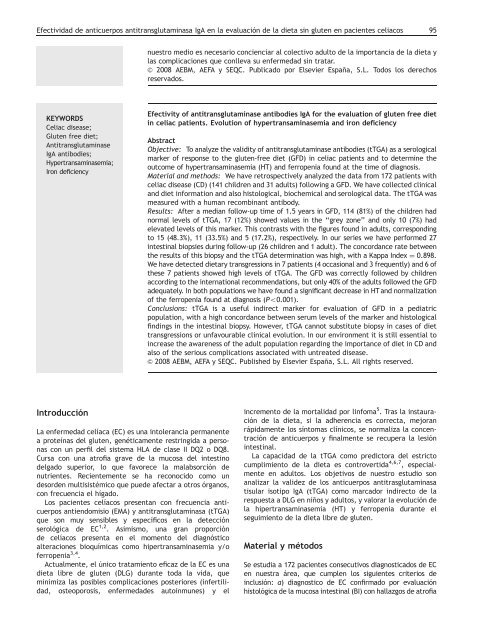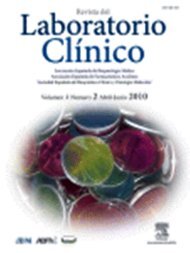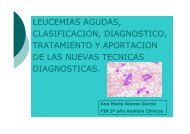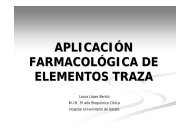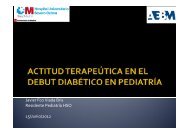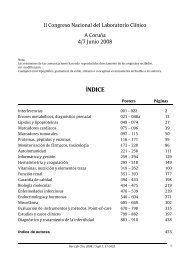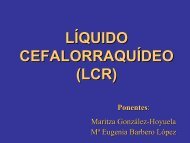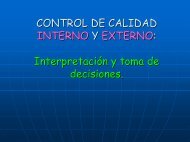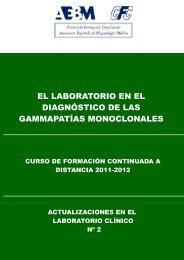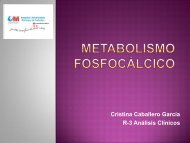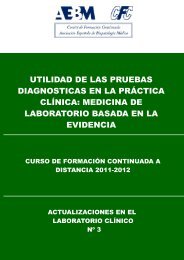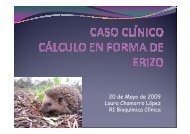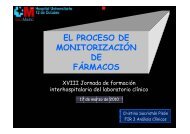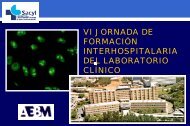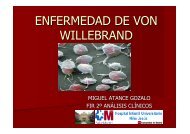Revista del - Asociación Española de BiopatologÃa Médica
Revista del - Asociación Española de BiopatologÃa Médica
Revista del - Asociación Española de BiopatologÃa Médica
You also want an ePaper? Increase the reach of your titles
YUMPU automatically turns print PDFs into web optimized ePapers that Google loves.
ARTICLE IN PRESS<br />
Efectividad <strong>de</strong> anticuerpos antitransglutaminasa IgA en la evaluación <strong>de</strong> la dieta sin gluten en pacientes celiacos 95<br />
nuestro medio es necesario concienciar al colectivo adulto <strong>de</strong> la importancia <strong>de</strong> la dieta y<br />
las complicaciones que conlleva su enfermedad sin tratar.<br />
& 2008 AEBM, AEFA y SEQC. Publicado por Elsevier España, S.L. Todos los <strong>de</strong>rechos<br />
reservados.<br />
KEYWORDS<br />
Celiac disease;<br />
Gluten free diet;<br />
Antitransglutaminase<br />
IgA antibodies;<br />
Hypertransaminasemia;<br />
Iron <strong>de</strong>ficiency<br />
Efectivity of antitransglutaminase antibodies IgA for the evaluation of gluten free diet<br />
in celiac patients. Evolution of hypertransaminasemia and iron <strong>de</strong>ficiency<br />
Abstract<br />
Objective: To analyze the validity of antitransglutaminase antibodies (tTGA) as a serological<br />
marker of response to the gluten-free diet (GFD) in celiac patients and to <strong>de</strong>termine the<br />
outcomeofhypertransaminasemia(HT)andferropeniafoundatthetimeofdiagnosis.<br />
Material and methods: We have retrospectively analyzed the data from 172 patients with<br />
celiac disease (CD) (141 children and 31 adults) following a GFD. We have collected clinical<br />
and diet information and also histological, biochemical and serological data. The tTGA was<br />
measured with a human recombinant antibody.<br />
Results: After a median follow-up time of 1.5 years in GFD, 114 (81%) of the children had<br />
normal levels of tTGA, 17 (12%) showed values in the ‘‘grey zone’’ and only 10 (7%) had<br />
elevated levels of this marker. This contrasts with the figures found in adults, corresponding<br />
to 15 (48.3%), 11 (33.5%) and 5 (17.2%), respectively. In our series we have performed 27<br />
intestinal biopsies during follow-up (26 children and 1 adult). The concordance rate between<br />
the results of this biopsy and the tTGA <strong>de</strong>termination was high, with a Kappa In<strong>de</strong>x ¼ 0.898.<br />
We have <strong>de</strong>tected dietary transgressions in 7 patients (4 occasional and 3 frequently) and 6 of<br />
these 7 patients showed high levels of tTGA. The GFD was correctly followed by children<br />
according to the international recommendations, but only 40% of the adults followed the GFD<br />
a<strong>de</strong>quately. In both populations we have found a significant <strong>de</strong>crease in HT and normalization<br />
of the ferropenia found at diagnosis (Po0.001).<br />
Conclusions: tTGA is a useful indirect marker for evaluation of GFD in a pediatric<br />
population, with a high concordance between serum levels of the marker and histological<br />
findings in the intestinal biopsy. However, tTGA cannot substitute biopsy in cases of diet<br />
transgressions or unfavourable clinical evolution. In our environment it is still essential to<br />
increase the awareness of the adult population regarding the importance of diet in CD and<br />
also of the serious complications associated with untreated disease.<br />
& 2008 AEBM, AEFA y SEQC. Published by Elsevier España, S.L. All rights reserved.<br />
Introducción<br />
La enfermedad celíaca (EC) es una intolerancia permanente<br />
a proteínas <strong><strong>de</strong>l</strong> gluten, genéticamente restringida a personas<br />
con un perfil <strong><strong>de</strong>l</strong> sistema HLA <strong>de</strong> clase II DQ2 o DQ8.<br />
Cursa con una atrofia grave <strong>de</strong> la mucosa <strong><strong>de</strong>l</strong> intestino<br />
<strong><strong>de</strong>l</strong>gado superior, lo que favorece la malabsorción <strong>de</strong><br />
nutrientes. Recientemente se ha reconocido como un<br />
<strong>de</strong>sor<strong>de</strong>n multisistémico que pue<strong>de</strong> afectar a otros órganos,<br />
con frecuencia el hígado.<br />
Los pacientes celíacos presentan con frecuencia anticuerpos<br />
antiendomisio (EMA) y antitransglutaminasa (tTGA)<br />
que son muy sensibles y específicos en la <strong>de</strong>tección<br />
serológica <strong>de</strong> EC 1,2 . Asimismo, una gran proporción<br />
<strong>de</strong> celíacos presenta en el momento <strong><strong>de</strong>l</strong> diagnóstico<br />
alteraciones bioquímicas como hipertransaminasemia y/o<br />
ferropenia 3,4 .<br />
Actualmente, el único tratamiento eficaz <strong>de</strong> la EC es una<br />
dieta libre <strong>de</strong> gluten (DLG) durante toda la vida, que<br />
minimiza las posibles complicaciones posteriores (infertilidad,<br />
osteoporosis, enfermeda<strong>de</strong>s autoinmunes) y el<br />
incremento <strong>de</strong> la mortalidad por linfoma 5 . Tras la instauración<br />
<strong>de</strong> la dieta, si la adherencia es correcta, mejoran<br />
rápidamente los síntomas clínicos, se normaliza la concentración<br />
<strong>de</strong> anticuerpos y finalmente se recupera la lesión<br />
intestinal.<br />
La capacidad <strong>de</strong> la tTGA como predictora <strong><strong>de</strong>l</strong> estricto<br />
cumplimiento <strong>de</strong> la dieta es controvertida 4,6,7 , especialmente<br />
en adultos. Los objetivos <strong>de</strong> nuestro estudio son<br />
analizar la vali<strong>de</strong>z <strong>de</strong> los anticuerpos antitrasglutaminasa<br />
tisular isotipo IgA (tTGA) como marcador indirecto <strong>de</strong> la<br />
respuesta a DLG en niños y adultos, y valorar la evolución <strong>de</strong><br />
la hipertransaminasemia (HT) y ferropenia durante el<br />
seguimiento <strong>de</strong> la dieta libre <strong>de</strong> gluten.<br />
Material y métodos<br />
Se estudia a 172 pacientes consecutivos diagnosticados <strong>de</strong> EC<br />
en nuestra área, que cumplen los siguientes criterios <strong>de</strong><br />
inclusión: a) diagnostico <strong>de</strong> EC confirmado por evaluación<br />
histológica <strong>de</strong> la mucosa intestinal (BI) con hallazgos <strong>de</strong> atrofia


